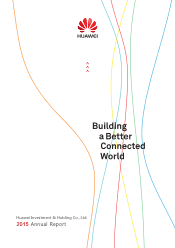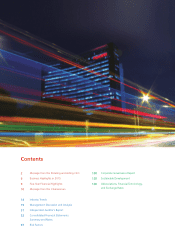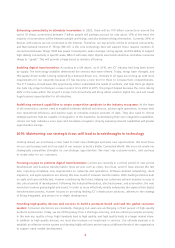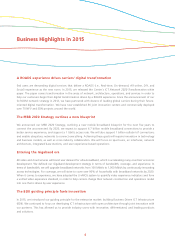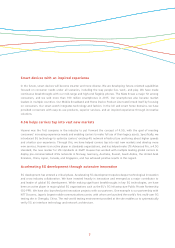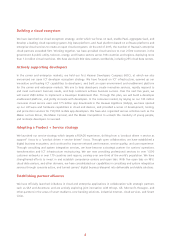Huawei 2015 Annual Report Download - page 6
Download and view the complete annual report
Please find page 6 of the 2015 Huawei annual report below. You can navigate through the pages in the report by either clicking on the pages listed below, or by using the keyword search tool below to find specific information within the annual report.4
Enhancing connectivity to stimulate innovation: In 2025, there will be 100 billion connections around the
world. Of these, connections between 7 billion people will perhaps account for only about 10% of the total; the
majority of connections will be between people and things, and also between things themselves. Currently, 99% of
devices with sensors are not connected to the Internet. Therefore, our top priority will be to enhance connectivity,
and Narrowband Internet of Things (NB-IoT) is the core technology that will support these massive numbers of
connections between things. With low power consumption, wide coverage, strong signals, and the ability to support
high-density connectivity in specific areas, NB-IoT will make static objects smart and interactive, and allow numerous
things to "speak". This will provide a huge boost to industry efficiency.
Enabling digital transformation: According to a UN report, as of 2010, the ICT industry had long been driven
by supply. The technology available determined the services that were offered. Today, things have changed, and
this supply-driven model is being replaced by a demand-driven one. Verticals of all types are coming up with more
requirements for our networks because ICT has become a new tool for them to increase their competitiveness.
The ICT industry should seize this opportunity, better understand the needs of verticals, and help them go digital.
Our Safe City project in Kenya is a case in point. From 2014 to 2015, this project helped decrease the crime rate by
46% in the areas within the project's scope. Full connectivity will bring about a better digital life, and will create
huge business opportunities for all industries.
Redefining network capabilities to create competitive symbiosis in the industry ecosystem: At the heart
of all connections, carriers need to establish software-defined architecture, achieve agile operations, increase their
own operational efficiency, and explore ways to monetize massive amounts of data. They also need to choose
strategic partners that are capable of integration. In the meantime, by developing their own integration capabilities,
carriers can help cultivate a more open and innovative ecosystem. Only by exposing network capabilities will greater
opportunities emerge.
2016: Maintaining our strategic focus will lead to breakthroughs in technology
Looking ahead, we must keep a clear head to meet new challenges and seize new opportunities. We must focus
on our core business and not lose sight of our mission to build a Better Connected World. We must not waste our
strategically competitive strengths on non-strategic opportunities. We must stay customer-centric, and continue
to create value for our customers.
Focusing on pipe to promote digital transformation: Carriers are currently in a critical period of new service
development and business transformation. New services such as video, the cloud, and IoT have entered the fast
lane, imposing completely new requirements on networks and operations. Software-defined networking, cloud
migration, and agile operations are driving this new round of network transformation. With leading solutions built
on agile and open architecture, Huawei is embracing the future, helping our customers achieve business success in
this critical period of development. Following the Industrial Revolution, electrical power, and automation, the next
revolution involves going digital and smart. In order to more effectively enable enterprises throughout their digital
transformation process, Huawei focuses on providing leading ICT infrastructure solutions, adheres to the strategy
of Being Integrated, and strives for in-depth development.
Providing high-quality devices and services to build a premium brand and lead the global consumer
market: Consumer electronics are constantly changing, but users are unchanging in their pursuit of high-quality
products and services. Today, we are shifting away from a shortage economy, and are entering a surplus economy.
In this new era, quality is king. High standards lead to high quality, and high quality leads to a larger market share.
In addition to high-quality devices, we must also increase our investment in services. Our ultimate purpose is to
establish an effective service system and develop highly efficient service teams at different levels of the organization
to support rapid market development.

